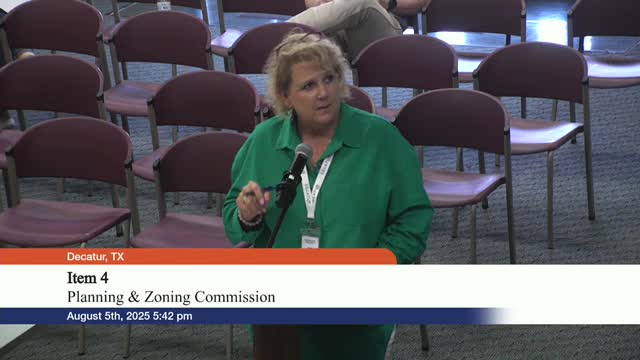City Council Approves Revised Fencing Ordinance for Better Buffering Between Properties
August 05, 2025 | Decatur, Wise County, Texas
This article was created by AI summarizing key points discussed. AI makes mistakes, so for full details and context, please refer to the video of the full meeting. Please report any errors so we can fix them. Report an error »

The Decatur Planning and Zoning Commission convened on August 5, 2025, to discuss a staff-initiated amendment regarding fencing and buffering regulations. This amendment aims to enhance the screening and maintenance requirements for properties, particularly those adjacent to residential areas.
The meeting began with a presentation outlining the proposed changes to the existing ordinance. Currently, a solid masonry wall between six to eight feet is mandated for buffering between residential and non-residential uses. However, this requirement has been deemed cost-prohibitive. The new proposal introduces a combination of fencing and landscaping options, allowing for more flexibility. Developers and property owners can now choose from privacy walls, privacy-style fencing, trees, shrubs, and earthen berms, or a combination thereof.
Specific requirements were detailed, including a minimum of four trees and 35 shrubs for every 100 linear feet in a 10-foot buffer area. The proposed fences must be at least six feet tall and constructed from approved materials. Additionally, landscaping must be installed outside the fence to enhance aesthetics and must reach a height of at least six feet within two years of installation.
The commission also addressed the maintenance of these features, emphasizing that property owners are responsible for the upkeep of both the fences and the landscaping. Dead or unsightly vegetation must be removed or replaced within 14 days of identification. The ordinance prohibits certain materials, such as unfinished wood and chain link, to ensure visual permeability and prevent line-of-sight issues, particularly on corner lots.
During the public hearing, questions arose regarding the enforcement of these maintenance requirements. It was suggested that regular inspections could be implemented to ensure compliance, with the possibility of a complaint-driven approach for violations. The commission acknowledged the challenges of maintaining landscaping in Texas's climate and expressed a commitment to developing a robust enforcement plan.
The commission plans to revisit the amendment for a second reading on August 25, 2025, with hopes for adoption. The discussions highlighted a proactive approach to balancing development needs with community aesthetics and environmental considerations.
The meeting began with a presentation outlining the proposed changes to the existing ordinance. Currently, a solid masonry wall between six to eight feet is mandated for buffering between residential and non-residential uses. However, this requirement has been deemed cost-prohibitive. The new proposal introduces a combination of fencing and landscaping options, allowing for more flexibility. Developers and property owners can now choose from privacy walls, privacy-style fencing, trees, shrubs, and earthen berms, or a combination thereof.
Specific requirements were detailed, including a minimum of four trees and 35 shrubs for every 100 linear feet in a 10-foot buffer area. The proposed fences must be at least six feet tall and constructed from approved materials. Additionally, landscaping must be installed outside the fence to enhance aesthetics and must reach a height of at least six feet within two years of installation.
The commission also addressed the maintenance of these features, emphasizing that property owners are responsible for the upkeep of both the fences and the landscaping. Dead or unsightly vegetation must be removed or replaced within 14 days of identification. The ordinance prohibits certain materials, such as unfinished wood and chain link, to ensure visual permeability and prevent line-of-sight issues, particularly on corner lots.
During the public hearing, questions arose regarding the enforcement of these maintenance requirements. It was suggested that regular inspections could be implemented to ensure compliance, with the possibility of a complaint-driven approach for violations. The commission acknowledged the challenges of maintaining landscaping in Texas's climate and expressed a commitment to developing a robust enforcement plan.
The commission plans to revisit the amendment for a second reading on August 25, 2025, with hopes for adoption. The discussions highlighted a proactive approach to balancing development needs with community aesthetics and environmental considerations.
View full meeting
This article is based on a recent meeting—watch the full video and explore the complete transcript for deeper insights into the discussion.
View full meeting
